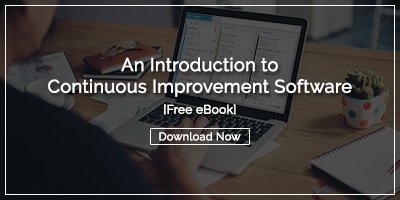 We get the chance to help organizations implement process improvement software every day. If you are considering using technology to boost your team’s efforts to increase the rate of positive change, congratulations! That’s a huge step, but implementations aren’t always as smooth as organizations would like.
We get the chance to help organizations implement process improvement software every day. If you are considering using technology to boost your team’s efforts to increase the rate of positive change, congratulations! That’s a huge step, but implementations aren’t always as smooth as organizations would like.
Here are a few tips that we’ve learned from our customers.
1. Don’t Expect the Technology to Be a Silver Bullet
Software can help spread and sustain a continuous improvement culture, but it is not a magic bullet. Before process improvement technology can be useful, there must be at least the start of a culture that will welcome it. Employees need to feel safe offering and acting upon ideas. Managers must be skilled at coaching and managing through change. Executives need to be clear that improvement work is a top priority. When those conditions exist, the improvement platform is far more likely to be used to its full potential.
2. Choose the Right Solution
In addition to checking all of the feature boxes, the improvement software solution you choose must be:
- Easy-to-use: These days, employees expect work applications to be just as easy to use as the consumer apps they use every day. By picking an intuitive solution, you’ll overcome many hurdles that keep people from engaging with technology.
- Available on mobile devices: Speaking of apps, modern workers want to participate from anywhere. It’s especially important that employees can submit ideas for improvement whenever and wherever they happen.
- Built for Improvement Work: If you are going to implement an improvement platform, make sure to choose one that is built for that purpose rather than general project management.
- Visual: People understand visual signals much more quickly than text. The platform you pick should help visualize improvement work with boards, charts, graphs, and dashboards.

3. Match the Solution to the Improvement Techniques Your Team Uses
There are many improvement management techniques that your team may use or plan to use. Make sure that employees know how they will be managed in the system. For example, managers should know how to note their Gemba walk observations and set up a PDSA cycle. Employees should know where to find Standard Work and how to submit opportunities to improve it. If you’ve been using physical huddle or kanban boards, be sure there is a plan to transition them to online boards.
4. Explain What’s In It For Employees
People are more likely to use any technology when they understand how it benefits them. Improvement management software is no exception. Ideally, every employee will know that quality improvement initiatives allow them to contribute to the organization in a meaningful way and ultimately do their best work. This is most likely to occur in organizations that recognize and reward people who engage in positive change.
5. Invite Feedback
Once people start using the solution, make sure they know that feedback is welcome. There may be opportunities for additional training or configuration to help people get more use from the system. It’s helpful to talk about which use cases are well supported by the system, and which don’t seem to fit. Together, you and your team can look for ways to overcome any challenges.
6. Show How the Data is Used
You are asking your employees to engage with a new software system; it requires effort and education on their part. Let them know that it is worth the effort by demonstrating how the system is used to make decisions. Explain how the reporting works, how KPIs are tracked, and what data executives look at every day.
7. Use the Solution for Goal Setting and Performance Evaluation
The right improvement management software can help you cascade goals down from the highest level strategy to individual employee objectives. This alignment leads to smarter decision making and more impact on the metrics that matter. Using engagement with improvement and the system as part of employee performance evaluation is also an effective tool for increasing adoption and engagement.
We hope you’ll consider KaiNexus as you look at technology to boost your improvement efforts. Still, even if you go another route, these tips should help you take the friction out of your quality software implementation.




Add a Comment